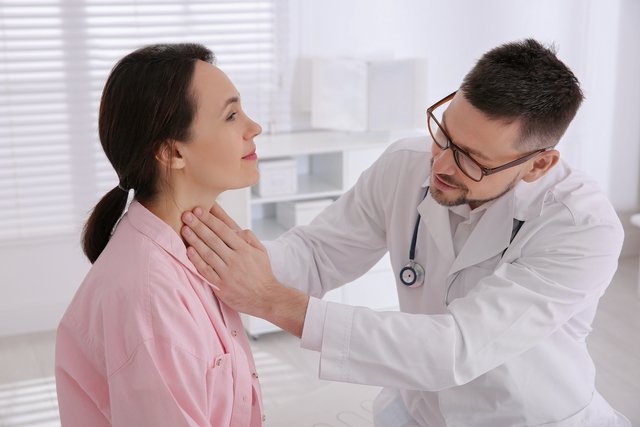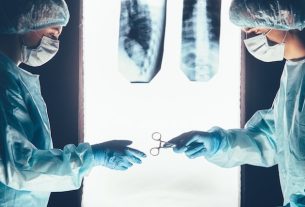Hodgkin’s lymphoma is a type of cancer that arises in the lymphatic system, which is made up of lymph nodes and other tissues whose function is to produce cells responsible for immunity.
In this type of cancer, also called Hodgkin’s disease, it is possible to see changes in immune cells, mainly in lymphocytes, which multiply excessively, becoming malignant and causing an inflammatory reaction, which leads to the appearance of lumps (lumps). swollen), fever and itchy skin, for example.
Whenever there are suspicious signs and symptoms of Hodgkin’s lymphoma, it is important to consult a general practitioner, oncologist or hematologist to carry out tests to confirm the diagnosis and identify the stage of the disease, helping to select the best form of treatment to achieve a cure.

Symptoms of Hodgkin lymphoma
The main symptoms of Hodgkin’s lymphoma are:
- Swelling of the lymph nodes (tongues), especially in the neck, groin or armpits;
- Fever;
- Weight loss for no apparent reason;
- Decreased appetite;
- Night sweats;
- Itchy skin;
- Enlargement of the abdomen due to an enlarged spleen.
In rarer cases, especially when the lymphoma is not identified and treated and affects other organs, it is possible to notice the presence of other symptoms such as chest pain, difficulty breathing, excessive tiredness, coughing, abdominal discomfort and symptoms of poor digestion.
In the presence of any symptom, it is important that the general practitioner is consulted so that tests can be carried out that can identify the lymphoma and, therefore, referral to a specialist, such as an oncologist or onco-hematologist, can be carried out and treatment can begin.
Don’t ignore the signs your body is giving you!
The diagnosis of Hodgkin’s lymphoma is made by an oncologist or onco-hematologist through evaluation of symptoms, physical examination with palpation of lymph nodes, and complete blood count with the aim of evaluating blood cells, mainly lymphocytes.
In addition, imaging tests, such as computed tomography, magnetic resonance imaging or PET scan, may also be requested to check the extent of the disease and its stage.
To confirm the diagnosis, the doctor may request a lymph node biopsy, or even a bone marrow biopsy performed by collecting a small sample of the pelvis bone, to check whether there is bone marrow involvement. See how a bone marrow biopsy is performed.
Possible causes
Hodgkin’s lymphoma appears when lymphocytes or precursor cells undergo genetic changes, which cause them to multiply excessively and transform into malignant cells, leading to the development of an inflammatory response, giving rise to symptoms.
The factors that lead to the development of changes in blood cells are not yet clear, however, people who have already had an infection with the Epstein-Barr virus, who are carriers of the HIV virus, who use immunosuppressive medications or who have first-degree relatives Those who have had this disease are more at risk of developing this type of lymphoma.
Hodgkin lymphoma stages
Hodgkin’s lymphoma can be classified into a few stages, namely:
- Stage I: there is involvement of only one group of lymph nodes or just one organ outside the lymphatic system;
- Stage II: there is involvement of two or more groups of lymph nodes on the same side of the diaphragm, which is the muscle located below the lungs and which separates the chest from the abdomen;
- Stage III: there is involvement of groups of lymph nodes on different sides of the diaphragm;
- Stage IV: there is involvement of lymph nodes and other organs outside the lymphatic system, mainly bone marrow, lungs and liver.
After identifying the stage of the disease, the hematologist, oncologist or general practitioner can indicate the most appropriate treatment so that a cure can be achieved.
Is Hodgkin’s lymphoma curable?
Hodgkin’s lymphoma is curable when it is identified in the early stages and treated immediately afterwards.
Furthermore, there are greater chances of cure when the person is under 60 years old, is able to carry out daily activities normally, has normal circulating LDH levels in the blood and has lymphoma in stage I or II and with metastasis in only one of the lymph nodes.
How the treatment is carried out
The treatment of Hodgkin’s lymphoma must be carried out under the guidance of an oncologist or onco-hematologist and may vary according to the stage of the cancer and the person’s age, with the aim of preventing the progression of the disease and promoting a cure.
The main treatments that may be indicated for Hodgkin’s lymphoma are:
- Chemotherapy: it is the most used treatment for this type of lymphoma and uses cytotoxic medications that eliminate cancer cells from the body;
- Radiotherapy: It is generally used after chemotherapy to reduce the size of the bumps and ensure that cancer cells are completely eliminated. However, it can also be used before chemotherapy if the areas are very large;
- Target therapy and immunotherapy: can be done in some cases, with medicines such as brentuximab vedotin, nivolumab or pembrolizumab, generally being used together with chemotherapy, or after bone marrow transplantation;
- Steroid medicines: They are used in more advanced cases of lymphoma to improve the effects of chemotherapy, improving symptoms and complementing treatment.
In more serious cases, in which Hodgkin’s lymphoma does not respond to treatment or recurs, it may be necessary to undergo chemotherapy with higher doses and, in these cases, it may also be necessary to undergo blood transfusions or bone marrow transplants, for example. example. See more details on lymphoma treatment.
Bibliography
- ADVANI, RH; et al. Brentuximab vedotin in combination with nivolumab in relapsed or refractory Hodgkin lymphoma: 3-year study results. Blood. 138. 6; 427-438, 2021
- SHAH, G. L.; MOSKOWITZ, C. H. Transplant strategies in relapsed/refractory Hodgkin lymphoma. Blood. 131. 15; 1689-1697, 2018
- KASEB, H.; BABIKER, H. M. IN: STATPEARLS (INTERNET). TREASURE ISLAND (FL): STATPEARLS PUBLISHING. Hodgkin Lymphoma. 2022. Available at: <https://www.ncbi.nlm.nih.gov/books/NBK499969/>. Accessed on June 27, 2023
- NCCN CLINICAL PRACTICE GUIDELINES IN ONCOLOGY (NCCN GUIDELINES). Hodgkin Lymphoma: Version 2.2023 — November 8, 2022. 2022. Available at: <https://www.nccn.org/professionals/physician_gls/pdf/hodgkins.pdf>. Accessed on June 27, 2023
- Highlights from the 2020 ASCO Annual Meeting. Pembrolizumab Improves Progression-Free Survival in Relapsed/Refractory Hodgkin Lymphoma. The Oncologist. 25. S1; S18-S19, 2020
- CASTELLINO, SM; et al. Brentuximab Vedotin with Chemotherapy in Pediatric High-Risk Hodgkin’s Lymphoma. N Engl J Med. 387. 18; 1649-1660, 2022
- INCA. Hodgkin lymphoma. Available at: <https://www.inca.gov.br/tipos-de-cancer/linfoma-de-hodgkin>. Accessed on June 28, 2021
- ABRAL. Manual – Hodgkin’s Lymphoma. Everything you need to know. 2020. Available at: <https://www.abrale.org.br/wp-content/uploads/2020/10/manual-de-linfoma-de-hodgkin-web.pdf>. Accessed on June 28, 2021

Sign up for our newsletter and stay up to date with exclusive news
that can transform your routine!
Warning: Undefined array key "title" in /home/storelat/public_html/wp-content/plugins/link-whisper-premium/templates/frontend/related-posts.php on line 12
Warning: Undefined array key "title_tag" in /home/storelat/public_html/wp-content/plugins/link-whisper-premium/templates/frontend/related-posts.php on line 13




